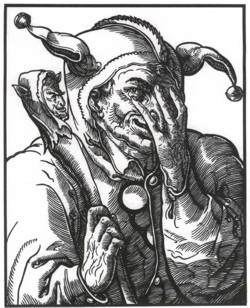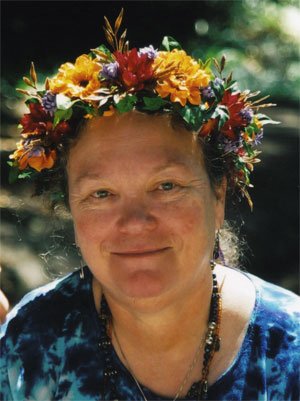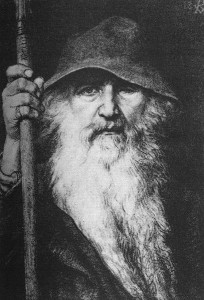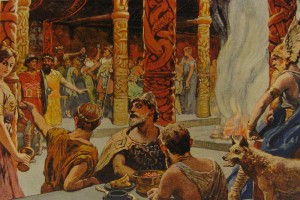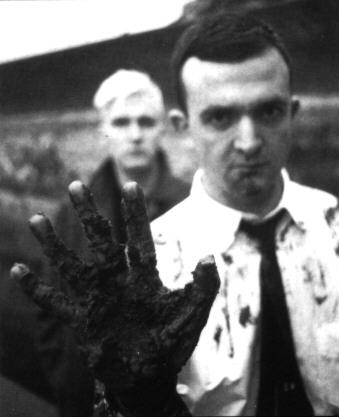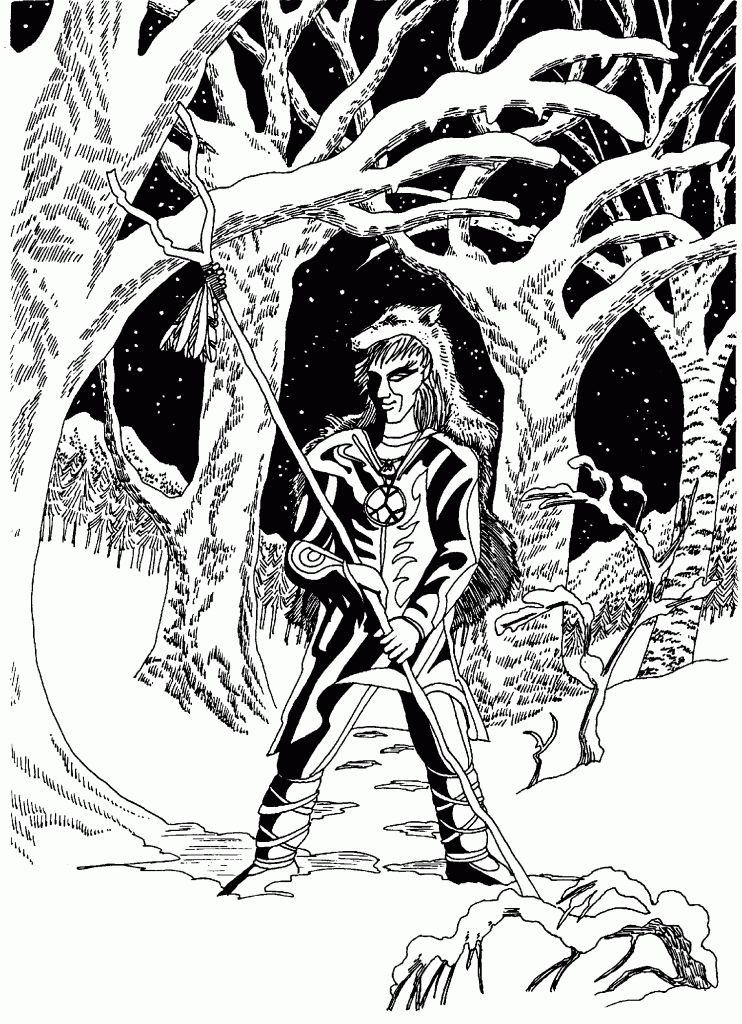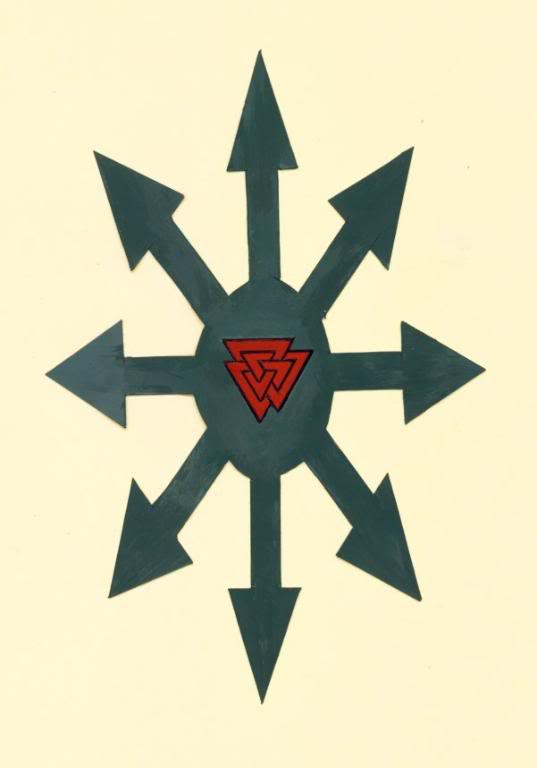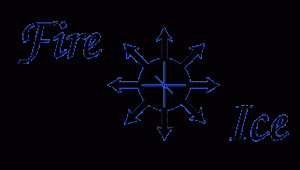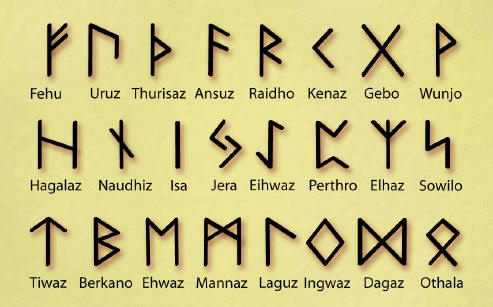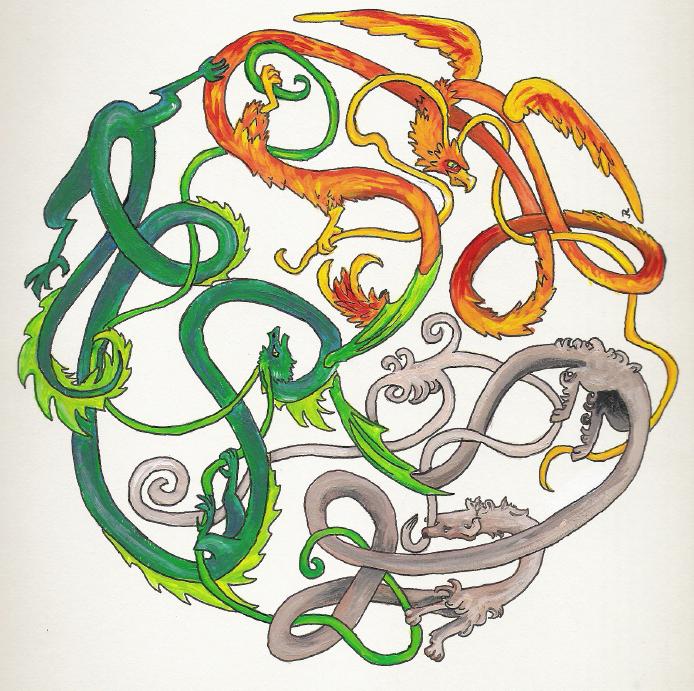I updated my biography with mythical elements that are not true in a ‘flatland’ logic sense. But they are true in the sense that they reveal the way my ‘dream self’ conceives reality. And in our days of gross materialism and spiritual illiteracy we forgot the language of Myth, Magic and Mystery. “Nature is a Language. Can’t you read?”, Coil once asked. And I ask myself, if I can read the language of my psyche and if I can learn to speak with her? I believe yes. I believe that this, in many ways, is part of practising magic. And I believe that such a language is encoded in the Runes. The Runes are far greater and far more mysterious than these 24 ‘letters’ look at first glance (or more or less than 24 depending on the Futhark you use; and there were many variations of each particular Rune). And, of course, our psyche speaks every night to us. Sometimes answers come in dreams. And most, if not all, spiritual philosophies emphasized that life itself is dream-like (that’s why they want us to wake up!). Others again purported that they can dream things into reality. Sometimes my life has been like this. Not really that I were dreaming things and then they happened (though I once dreamt that my grandmother will die a half year before it happened), but that I was longing for things or wanted some things to happen in a really strong way and then they happened. One thing was that I wanted to write about magic and other things that I feel deeply attracted to and – hocuspocus abracadabra – a guy named Henry asks me, if I’d like to write something for Elhaz Ablaze. Things like that, you get the picture. Life can be full of such coincidences. That doesn’t mean that life is about fulfilling every desire or that with magic ‘anything is possible’ like some New Age dreamers believe (or some newcomers to magic – no, not me, I never believed such childish nonsense :-). But what I’m talking about is that daydreams, secret desires, fantasy identities or other aspects of ourSelf can tell a great deal about where we want to go, who we want to be and what NEEDS to be done, if we are to become successful in our lives (a success defined by ourselves, not some normative ideas society holds). This in many ways is what Crowley called ‘the discovery of one’s True Will’. A Will, I believe now, that is more to be understood as a dynamic force and a PROCESS, not a static aim we have to get to. Matt Anon is such a ‘creation’ of my ‘dream self’. He is something my ‘everyday self’ (my persona) is not, but he embodies qualities to which I aspire. Anon is a ‘future self’ that functions as an attractor, a magical self that can do things ‘I’ couldn’t normally do. (At least, this is the ‘trick’ here.) And this is one of the definitions of magic: ‘Magic is a way to make things happen that ordinarily would not happen.’ (Flowers 1997: Lords of the Left Hand Path, p. 3) However, the test for the aspiring magician is mundane reality. A reality that must not be rejected, but one that is our arena and our playground. With work, discipline and one-pointedness it is possible to reach a sense of destiny, a destiny created by the magician – not karma, fate or chance.
By Matt Anon
Interview with Diana Paxson
I want to say that Diana was extremely friendly and kind. She leads the Hrafnr Community in California. I must thank her very much! For books by Diana Paxson check out our Elhaz Ablaze Bookshop.
Interview with Diana Paxson
This interview is part of an academic investigation of the practices of Seidhr in the postmodern world. Could you tell me a little bit about your background in the area of magic(k) and/or Neo-Paganism and how you came to practice Seidhr?
My first magical training was in a ceremonial tradition based on the work of Dion Fortune. After several years, I felt that I needed to balance that with a more energetic and ecstatic practice, so I began to work with the techniques in Michael Harner’s book on shamanism. However these techniques, although very well presented and effective, lacked the substance that comes from a cultural tradition, but I had no connection to any of the Native American or other cultures. When I was doing research into Norse mythology I had seen references to seidhr, which sounded like a northern European magical tradition that I could explore without the danger of cultural appropriation. Unfortunately, at that time, I knew of no one who was practicing it, so I had to figure it out for myself, using what I had learned in other traditions about spirit journeying and trance work to interpret and flesh out the information in the lore.
Where does Seidhr come from? What was Seidhr in the past and what is Seidhr today?
In the Eddas and sagas, Seidh is used as a term for a variety of magical practices which involve a trance state and is often translated into English as “witchcraft”. The list of skills ascribed to Odin in Ynglingasaga (although presented in negative terms) is similar to lists
of shamanic practices from other cultures. The oracular practice described in the saga of Eirik the Red and other sagas is also called seidh (or spae). It is said to have been taught to the Aesir by Freyja.
Oracular Seidh is the best known form today. The process I developed is based on the sources given in my answer to question 4. I have trained people all over the US, in England, and in Holland. Many have taken the basic approach and developed their own variations.
Why do you think Seidhr should be practiced? What does result from practicing Seidhr?
Oracular seidh is a community service, a way to provide insight and counsel. Other forms of seidh can be used for healing, inspiration and to gather information.
What sources have inspired you to take up the practice of Seidhr? What sources have you studied / read?
1. The sagas, especially the saga of Eirik the Red, which includes the most explicit description of any Norse religio-magical ceremony that we have.
2. The Eddic poems in which Odin visits the Völva in hel to question her: Baldrsdraumar, The shorter seeress’ prophecy, and Völuspá.
3. Saxo and other sources that describe journeys to the Otherworld.
James Chisholm has put together a sourcebook of references to seidh, published by RunaRaven Press.
Do you think one has to speak Old Norse or has to study the original sources to be able to practice Seidhr?
In order to understand the references in the lore it is useful to at least compare several translations and look up problematic words in an Old Norse dictionary, as modern languages have a more limited vocabulary, and terms are often mistranslated.
Despite the fact that the term ‘shamanism’ is itself controversial outside the context of Siberian shamanism, do you believe that Seidhr is a kind of ‘Northern Shamanism’? Does Seidhr feature shamanistic elements?
I find “shamanistic” to be a useful term for practices that resemble those found in true shamanic cultures. Ethnographic research (see Eliade’s „Shamanism“) indicates a remarkable similarity of practices in widely separated cultures. I believe that such practices were once
world-wide, and some may have survived in the Indo-European cultures. It is also possible that the Norse borrowed practices from the Finns and Saami (just as the latter borrowed some elements from Norse mythology). Oracular seidh, though it uses many of the same skills, in format is clearly part of the Indo-European oracular tradition.
What are the differences between shamanism and Seidhr? What are the specifics of Seidhr?
My understanding of the way “shamanism” is now being used is that it properly is applied to the practices of tribal hunter/herder-gatherer cultures, with the classic initiatory and other experiences.
By the saga-period, practitioners of seidh play a more anomalous role in their societies, except for the seers, who seem to have been highly respected. Because terms such as “seidhjallr” are used in connection with spae, I classify it as a subset of Seidh.
Do you consider Seidhr as part of the ‘Northern Tradition’ / Teutonic-Germanic Religion?
Although not universal, oracular seidh is practiced in a number of heathen communities in the U.S. In my opinion seidh is the proper term for such practices in Asatru. Groups basing their practice on Anglo-Saxon or Continental Germanic ways might find other terms (such as
“hexerei”). Certainly “Seidh” is the best-known and most popular term for Teutonic-Germanic magic.
What is the role of women in Seidhr? Is Seidhr somehow more connected to women?
In Ynglingasaga we are told that in earlier times both men and women practiced seidh, but that later it was considered so “ergi” that it was only taught to priestesses. Apparently as the Norse became acculturated to European Christian ideas, the status of women and anything requiring receptivity was lowered. Thus, except for the seidhmadhrs persecuted by the Norse kings, the seidh workers we read about in the lore are female.
I have trained both men and women in seidh, and both are quite able to master the skills. It is true, however, that those who continue to practice seidh and make it part of their Asatru identity include more women and gay men than straight men.
Is it ‘unmanly’ to practice Seidhr? What does that say about the role of men and women in (ancient) Germanic culture? How is this seen in (post)modern
Neo-Paganism / Ásatrú?
See above, and for a full analysis, see my article, “Sex, Seidh, and Status” (http://www.seidh.org/articles/sex-status-seidh.html)
Germanic Neo-Heathenism has been often accused of being racist / right-wing? Why do you think that is the case? Can descendents of non-European cultures be part of Ásatrú?
This is a topic that has been discussed exhaustively by contemporary heathens. For an analysis, see Chapter 7 of /Our Troth, Vol. 1/. Essentially, opinions range from those who believe that anyone who feels called by the Germanic gods can worship them to the splinter groups who think that Asatru is the natural religion of a superior white race. The heathen emphasis on family and heritage means that for many, their descent from Germanic peoples is one motive for becoming heathen, however, at least in the U.S., everyone has been formed by speaking a Germanic language and living in a culture shaped by Germanic ideas, so we all have a Germanic cultural heritage.
Why do you think so many people feel attracted to Neo-Paganism today (including Wicca, Druidry & Ásatrú)?
There are many reasons: the Abrahamic religions don’t deal well with the feminine or the environment, many of them fail to help people connect with Spiritual Power, focusing on sin and guilt is depressing, and finally, Monotheism doesn’t really make sense (see John Michael Greer’s „A World Full of Gods“).
Finally, what answers does Heathenism / Paganism have to the condition of the modern world (including modern challenges like climate change, overpopulation, financial crisis etc.)? In which way does it help to improve the conditio humana? (I would also like to ask in this context: Why is it ‘better’ than the monotheistic cults?)
To properly address any one of these questions would require a book. In brief, Paganism in general sees humans as part of the natural world, not superior to it, and teaches harmony and cooperation rather than exploitation. If we understand natural law and apply it to our own
actions, we have a better chance of restoring balance in all areas of life, and thus human, as well as natural survival.
Heathenry in particular offers a strong ethical system with an emphasis on personal responsibility, and plenty of inspiration for meeting adversity with courage. One popular saying is, “We are our deeds.”Polytheism makes more sense because no matter how hard people try to deal with the Divine as an all-powerful, etc. universal Being, so long as we are in human bodies, we inevitably personify our gods and in doing so, limit them. The solution is to have many deities that cover all aspects of existence.
Heathens tend to think of their deities as friends or relations, senior partners in the fight to preserve the world.
Skaal,
Diana.
Chaos and Mystery
...it is easier to sail many thousand miles through cold and storm and cannibals, in a government ship, with five hundred men and boys to assist one, than it is to explore the private sea, the Atlantic and Pacific Ocean of one’s being alone.
Henry David Thoreau, „Walden“
In such a union „each element achieves completeness, not directly in a seperate consummation, but by incorporation in a higher pole of consciousness in which alone it can enter into contact with all others.“ (Teilhard de Chardin) Tillich was expressing the same thought when he denied that union with the Ground of Being means a loss of self in a larger whole. „If the self participates in the power of being-itself,“ said Tillich, „it receives itself back. For the power of being acts through the power of the individual selves. It does not swollow them as every limited whole, every collectivism, and every conformism does.“
Braden, „The Private Sea – LSD and the Search for God“
There are two souls living in my breast. Goethe said that. And I often feel the same way. On the one hand there is the „Anarch“ (Ernst Jünger), the free spirit („Freigeist“), the one, who dares to live without certainty and follows his own path… …and then there is the one, who follows more systematic approches to Mystery by more experienced magicians, the one, who needs some guarantee that he’s on the right track, someone who believes that someone ‘out there’ might have THE answers. Ironically these antagonistic forces in my soul led me once into the arms of the OTO. They promise freedom of speech and individualism, but practice dogma, rigidity, hierarchies and, ultimately, the subordination of the individual under certain ‘truths’ (read DOGMA=AMGOD). The fine line where freedom of speech ends and dogma begins is not easily seen, especially when you’re a 19 years old occultist, who believes in the Great White Brotherhood (I know why cynics exist). However, when I study the magical systems of others and try to follow their approaches to the Mystery, I always get stuck at some point where I begin to question some (or all) of their basic premises. This always leads me to the same conclusion: that I’m not a follower type, that I want to create my own philosophy and that there are Masters and Magicians who can help along the way, but there are no guarantees. If I may just quote a quote that resonated deeply with my being:
„Theoretical loyalty provides clear direction but is inherently limiting; theoretical anarchy enables flexibility but also inserts uncertainty…there are no fixed and correct ideas or methods…and therefore no inherently right ways…“
Just think about it: Theoretical Anarchy enables flexibility but also inserts Uncertainty! Don’t we all just yearn for that absolute certainty? But with absolute certainty Mystery ceases to exist. Hasn’t the world reached that point already? The way of the world is not my way… Uncertainty means freedom, certainty means dogma.
To trust my own instincts is the hard part of the equation. I do, but not all the time. However, doubts and conflicts have always been an important part of my path. They have often created a Need-Fire (Nauthiz), which led me to new horizons beyond what any magical model can describe as every model is „a map, not the reality“ (RAW). This dynamic of ‘friction-resistence-breakthrough’ was also behind the process to go beyond Crowley’s Thelemic model that finally culminated in the termination of my OTO membership in 2006 (and that dynamic is behind many other important processes that led to inner development). I regard this step as one of my most important ones towards an independent magical path.
In Occultism there is the tendency to explain everything, to package the Mystery in a formulae. Crowley’s teachings are full of such formulas and they explain a lot, but ultimately mean nothing. They may be used, but after all they cloth the Mystery in some costume. But this costume is not the Mystery itself. The Mystery is sensed in a certain state of consciousness (usually a kind of gnosis in a CM sense) and fills the seeker with awe. (Rudolf Otto described this awe in his work about The Holy and called the two emotions of man when he encounters the Divine mysterium tremendum and mysterium fascinans.) And after such an experience the seeker tries to rationalize what he experienced by creating certain correspondences between his experience and the system he’s using. He does this by assigning certain concrete elements of his experience to certain abstract qualities of his system-in-use. Too abstract? Ok, I give you an example:
Let’s say I invoke my Genius / HGA / Augoides / Wode-Self / Fylgja (what ever you want to call it – I’m not saying it’s all the same thing; the HGA seems to represent a combination of Wode-Self and Fylgja) and I’m deeply rooted in the Kabbalistic Psychocosm. If you invoke that part of your psyche in that system you will do it with surrender and love and, maybe, with submission. After you have established a rapport with your Deep Mind a voice starts speaking (not necessarily verbally, but visually or otherwise) that seems to come out of the core of your very existence (one-dimensional, uneducated and spiritually underdeveloped primates often think they met „God“). After this mysterious experience you turn towards your Tree of Life and assign that experience to Tiphareth. This corresponds to the Sun and the Heart. This again is connected to the Anahatha-Chakra, which leads to another chain of correspondences. In modern QBL these can be connected to the Hebrew aphabet and Tarot cards, so that finally a psychocosm full of correspondences is created. Too many are obsessed with the symbols, signs, correspondences, colours etc., so that they forget what the initial intention was behind to use them in the first place. And that’s basically to allow the mind to focus and use all those tools as keys for opening the doors of perception and thus to reach higher states of conciousness. BUT, once you are there, as Isreal Regardie never stopped emphasising, throw away the ladder, because you don’t need it anymore! All too often from such correspondences predetermined routes to „enlightenment“ (also known under its mysterious name „delusion“) are created that alienate the true seeker from the goal.
So, what is the goal? In my experience the first and foremost aim is to experience reality directly, without immediately conceptualising and contexualising the experience itself. Though I don’t deny the usefulness of certain concepts I realize that it’s all to easy to take the package for the content. Honestly said, I believe that my path has often revolved around CONCEPTS (package) explaining some of my (hardly to explain and hardly to accept) mystical and/or magical experiences (content). This, I believe, is the reason why Jan Fries said in my interview that „I believe that the individual is a lot more important than any system, religion, cult or school. And if you have to stick a label to yourself to do your thing you ain’t good enough yet.“
Labels, they give certainty, don’t they? Words are more real than reality – for most of us. But in truth we’re caught in our own prison of concepts most of the time.
Ludwig Feuerbach, the first real atheist we know of (maybe the Greeks had also some examples of what we think of as ‘atheists’ today) showed how to free man from the concept of a transcendental being called „God“. He was a German philosopher, who declared that God was nothing but the projection of human qualities in their perfected form. He argued that the superhuman deities of religion are involuntary projections of the essential attributes of human nature, and this projection, in turn, is explained by him by using a theory of human consciousness that is heavily indepted to Hegel. Feuerbach is really the unrecognised father of the criticism of religion, because whatever was interesting in Feuerbach has been taken up by Marx and Freud (I’m not saying they’re right), who formulated their theses in a more logical, coherent and systematic fashion. However, Feuerbach proved that ‘God’ is just a WORD (label). But wait, words are more real than reality, right? In the beginning was the word… and the word was God. (By negating the existence of God – after his daughter has died at a very early age – Feuerbach has been prohibited to publish his works.) But those of us who experienced the Divine (content) cannot believe in the explanations of religion (package). And isn’t it strange that those Christians, who encountered the Divine in mystical experiences (like Meister Eckhart, Jacob Böhme, Paracelsus, Giordano Bruno, Blaise Pascal etc.) were doomed by the Church and that the Fathers of Dogma (who are the fathers of fear) became the patrons of this alien creed called Christianity? Before they imposed their dogmas on our forefathers and foremothers we had no conception of THE Divine (as the “One God”), but experienced that quality of reality (or consciousness – after all, I don’t know, if it has an objective reality) in different forms (thus polytheism). So, if Feuerbach is right (albeit a materialist), then he is confirming the mystical premise that the Gods live in our breasts. Thus the projections of “the superhuman deities of religion” that man has created aren’t mere illusions of human consciousness, but become an essential expression of the divine nature of Consciousness itself (Óðr).
In this way the label “God” degenerated into a concept that man has to believe in, instead of being the vision of each man realizing the core of his very existence. (I finally have to read Emerson. I know that he had a lot to say about that.) This imprisonment to labels is the hypnotising effect of language itself and due to an “evolutionary error” in our brains to ceaselessly create meaning. Zen Masters and other Masters of Meditation developed all kinds of techniques –including shock techniques, gazing at walls for hours, silence, sensory deprivation, mantras, mudras, yantras etc. – to overcome that miserable condition, also known as the conditio humana.
What I learn from this is that being a chaos mystic – doing your own research, experiments, rituals, meditations asf., and trusting your own experiences and your own perception, asking any premise and any dogma, system or preacher – is the only way to go. We can learn from those who walked the Path before us (magicians and mystics), we can learn to read their sign posts (symbol systems) and explanations (philosophies), but after everything is said and done, whom will you trust when you’re in danger or when death approaches? Your guru, your system, your God?
My answer is: “No, I will trust mySelf.”
This Self, I believe, is part of the Divine energy of godhead that creates and maintains the universe, who is the Alföðr and whom the Einherjar called Óðinn.
Persistence is all. Search continues…
The Pagan Prophet: Remembering Jhonn Balance
Dedicated to the Great Heart and Great Soul of the Great Shaman Jhonn Balance
16 February 1962 to 13 November 2004 :
I don’t expect I’ll ever understand
How life just trickled through my hand
Jhonn Balance
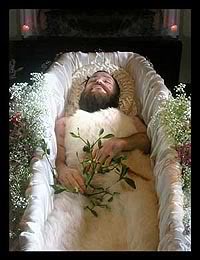 Jhonn dead dead dead. May he be blessed by all horned animals. IO PAN IO PAN IO PAN PAN PAN! “Death knows, death goes, death blows, death shows… Does death come alone or with eager reinforcements? Holy Holy Holy”
Jhonn dead dead dead. May he be blessed by all horned animals. IO PAN IO PAN IO PAN PAN PAN! “Death knows, death goes, death blows, death shows… Does death come alone or with eager reinforcements? Holy Holy Holy”
“Do what thou wilt shall be the whole of the Law.
I
IT IS WRITTEN in The Book of the Law: Every man and every woman is a Star. It is Our Lady of the Stars that speaketh to thee, O thou that art a star, a member of the Body of Nuith! Listen, for thine ears become dulled to the mean noises of the earth; the infinite silence of the Stars woos thee with subtile musick. Behold her bending down above thee, a flame of blue, all-touching, all-penetrant, her lovely hands upon the black earth, and her lithe body arched for love, and her soft feet not hurting the little flowers, and think that all thy grossness shall presently fall from thee as thou leapest to her embrace, caught up into her love as a dewdrop into the kisses of the sunrise. Is not the ecstasy of Nuit the consciousness of the continuity of existence, the omnipresence of her body? All that hath hurt thee was that thou knewest it not, and as that fadeth from thee thou shalt know as never yet how all is one. Again She saith: I give unimaginable joys upon earth, certainty, not faith, while in life, upon death. This thou hast known. Time that eateth his children hath not power on them that would not be children of Time. To them that think themselves immortal, that dwell alway in eternity, conscious of Nuit, throned upon the chariot of the sun, there is no death that men call death. In all the universe darkness is only to be found in the shadow of a gross and opaque planet, as it were for a moment; the universe itself is a flood of light eternal. So also death is but through accident; thou hast hidden thyself in the shadow of thy gross body, and taking it for reality, thou hast trembled. But the orb revolveth anon; the shadow passeth away from thee. There is the dissolution, and the eternal ecstasy in the kisses of Nu! For inasmuch as thou hast made the Law of Freedom thine, as thou hast lived in Light and Liberty and Love, thou hast become a Free-man of the City of the Stars.
II
LISTEN AGAIN to thine own voice within thee. Is not Hadit the flame that burns in every heart of man, and in the core of every star? Is not He Life, and the giver of Life? And is not therefore the knowledge of Him the knowledge of Death? For it hath been shown unto thee in many other places how Death and Love be twins. Now art thou the hunter, and Death rideth beside thee with his horse and spear as thou chasest thy Will through the forests of Eternity, whose trees are the hair of Nuit thy mistress! Thrill with the joy of life and death! Know, hunter mighty and swift, the quarry turns to bay! Thou hast but to make one sharp thrust, and thou hast won. The Virgin of Eternity lies supine at thy mercy, and thou art Pan! Thy death shall be the seal of the promise of our agelong love. Hast thou not striven to the inmost in thee? Death is the crown of all. Harden! Hold up thyself! Lift thine head! breathe not so deep–die!
III
OR ART THOU STILL ENTANGLED with the thorny plaits of wild briar rose that thou hast woven in thy magick dance on earth? Art not thine eyes strong enough to bear the starlight? Must thou linger yet awhile in the valley? Must thou dally with the shadows in the dusk? Then if it be Thy Will, thou hast no right but to do Thy Will! Love still these phantoms of the earth; thou hast made thyself a King; if it please thee to play with toys of matter, were they not made to serve thy pleasure? Then follow in thy mind the wondrous word of the Steele of Revealing itself. Return if thou wilt from the abode of the Stars; dwell with mortality, and feast thereon. For thou art this day Lord of Heaven and of Earth.
Love is the law, love under will.
The Benediction of the All-Begetter, All-Devourer be upon thee.”
(Aleister Crowley, Liber CVI: Concerning Death, Copyright OTO)
Today five years ago, John Balance died in a tragic accident. Goeffrey Rushton, better known under the name Jhonn Balance, is an artist whose art, life and magick has inspired me in many ways, when I was a teenager. John has started out as a fan of the infamous ‘Wreckers of Civilization’, Throbbing Gristle, where he met Peter ‘Sleazy’ Christopherson, his life partner and co-founder of their band Coil. They founded the band Psychic TV and Thee Temple Ov Psychick Youth with Genesis P-Orridge in 1981 (as far as I remember). After arguements they both left TOPY and Psychick TV to follow their own creative spark and to break free from TOPY that seemed to turn into a trap of a cult, as they said.
“Genesis is definitely, concretising ideas from various traditions, but we assumed the mantle of organised religion, copying aspects of The Process Church, Jim Jones and actual clerical stuff, and we came across as a cult, but we were in fact individually practicing sexual magic. So that was a camouflage, which eventually became a trap that we had to break away from. I felt very strongly that we had to get away from that.”
Their first mini-album has become How to Destroy Angels, ‘music(k) for the accumulation of male sexual energy’, which is to say that men could use it for homosexual magic(k) (though they said that women could use it, too). Their following albums Scatology and Horse Rotovator are a testimony to their brilliance and that they have always been ahead of their time (like with most albums that followed). John Balance was responsible for vocals, lyrics, chants, synthetics and various esoteric sound-making instruments and devices. Outside of Coil he collaborated with Nurse With Wound, Death In June, Psychic TV, Current 93 and Thighpaulsandra, and produced a couple of Nine Inch Nails remixes. His early work and wide-ranging collaborations made him one of the most influential figures in the industrial, experimental minimalist and neofolk music scenes. Peter Christopherson is the ‘unseen’genius behind the inimitable sounds and ‘styles’ that Coil has invented. He wasone of the original members of the band that invented the genre of Industrial Music, Throbbing Gristle, co-founded Psychic TV and Coil. Christopherson has participated in the reuniting of Throbbing Gristle (I think in 2004) as well as composed an album for his current solo endeavour The Threshold HouseBoys Choir (now SoiSong).John and ‘Sleazy’ have nurtured the entity called Coil for 23 years.
John Balance has influenced me on many levels. First of all, Coil helped me in times of isolation in ways I hardly can describe. They helped me to come to terms with the fact that I am an outsider and that I’m neither mad nor alone. (In fact Sleazy once told me in Berlin that “it’s very important to be an outsider”!) The music of Coil displayed an orginality and a creativity that showed that ‘occult experiences’ are real and can be ‘translated’ into sound. John was initially influenced by Max Ernst and the surrealists. Later P-Orridge and Burroughs introduced him to the general concept of magic as a practicality in everyday life. After having been asked how magic has sweeped into his work, he answered:
“Well it has, totally. I’ve always been into magic, with Crowley’s ‘k’, and studied it. I tried to buy stuff by Crowley when I was young, but my parents absolutely refused to have anything to do with it and actively discouraged me. I wrote to Alex Sanders (King of the Witches), when I was 14, and he wrote back to me saying thanks for writing, I’m very pleased that you want to do this, but can you write back when you’re 18. He wouldn’t accept anyone so young into his coven. I used to worship the moon too, I’d encourage other boys at school to do it, too. I just instinctivelydid things like that. It once got me into trouble. I was at school with the son of David Tomlinson, who was in Bedknobs and Broomsticks (a Disney comedy about witches). The two of us were taught astral projection by a teacher and there was a scandal because they thought there was some homosexual relationship going on with the three of us, but there wasn’t. I went to school one day and there was David Tomlinson’s limousine outside -he grabbed me as I was coming off the school bus and asked whether his son and I had a sexual relationship with this teacher. From then on, all the teachers were watching me!”
Asked at which point he started to practice magick, he said:
“…even as a kid I used to do it. I was an only child, always talking to animals, fantasy creatures and spirits. I would make little plasticine gods and make offerings to them. I was just born with a pagan sensibility. I’m an animal, I’ve never been a human – there’s no difference between animals and humans to me. I think that’s one of the signs of a true pagan. Some life experiences can just jolt you into it. I had German measles really badly, twice I think, and wasn’t allowed contact with the light in case I went blind. Shut in this dark room, that was like my initiation, I imagine.”
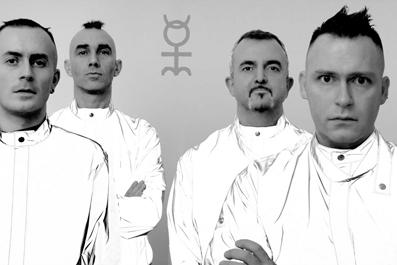 Ossian Brown, Thighpaulsandra, Peter “Sleazy” Christopherson and Jhonn Balance
Ossian Brown, Thighpaulsandra, Peter “Sleazy” Christopherson and Jhonn Balance
However, it was really Spare who got him into a way of magick that was truely his. “As soon as I discovered Austin Spare I realised that we were loners, we practiced magick on our. That’s my style of magic, the shamanic way – and Spare was definitely a shaman.” Like Spare did paint pictures in a sidereal fashion, where images and gestalts are infused into the realm of Midgard, Coil did a sidereal sound, where ‘the Other’ – the Mystery – (Runa?)pours into mundane reality.
“What Spare did in art, we try to do through music. This is why we do sidereal sound. The way he twisted his pictures, so that the geometry appears warped, we try to do that, to produce strange geometries through sound, so that it comes out sideways. We do it with technology, with 3D devices, phasers, out-of-phasers, all sorts of gizmos. There’s no one particular box that does it, we all do it any possible way that we can. … Spare used to do speaker battles, where he would project sound into the aether – which I think is a real physical thing, some kind of cosmic glue, a genuine substance, or non-substance – that connects everything and allows unexplained things and ideas to be transmitted.”
 Austin Osman Spare painting you
Austin Osman Spare painting you
John Balance had a very intimate relationship with Spare. He did sigils to ‘contact’ Spare and his Current of the Zos Kia Cultus. After that Coil were in touch with Crowley’s and Spare’s art forever. In many ways Balance was overwhelmed by the results of his magical workings. They collected many artifacts from these two artists and magicians. Balance claimed that you can commune with the pictures of Spare and that they would change.
“Some of the chaotic ones, you look at them with one person and see certain hings, and you look at them with another person and you see a completely different set of things. Every piece he did was magical. There were some that were done for other people specifically as magical spells, such as the stele or the magical alphabet. But he lived his life as a magician and a stoic. He could survive for a week on a kipper… Austin Spare had people who came through for him, spirit guides, and there are magical currents. He may have opened up a gateway or whatever, but now it’s flowing in trickles, rivulets, even streams. That’s why it’s very important that we flash Zos Kia Cultus – Spare’s magical philosophy or code – and his images onto the screen at our performances, to energise Spare’s current and put our own energies into it. To make it a living, breathing, energising, wonderful thing. By Cultus I don’t mean a cult, but a way of life, a philosophy, a code, which puts me in touch with what I really, truly should be doing onthis planet.”
 Existence, by Austion Osman Spare
Existence, by Austion Osman Spare
And this means really – albeit in a different context – what Ódhinn meant by the saying that “I Give myself to mySelf”: that you would totally dedicate yourself to the divine current you come in touch with. Everything you do becomes you. There is no difference between your everyday life as Joe and your magical persona. You do not only do, but you become magick. “Like Burroughs, or Spare, there’s no difference between our philosophy, our lifestyle and our art. This is what we do. We are what we do.” Well, my friends, and this is what I call Chaos Heathenism in action. However, there is a dark side to all of this. Jhonn (as he later spelled himself) suffered from two demons: depression and alcoholism. He struggled with both of them his whole life. And as Peter has told me, his alcoholism started when they were doing E’s (MDMA) in the mid-80s and Jhonn began to use alcohol for ‘coming down’ from them. On November 11th 2004 Jhonn fell down the stairs in his house after having been drunk for weeks. He never again regained consciousness and died on November 13th 2004.  Lost Balance
Lost Balance
This has been one of the saddest days of my life. I was to perform my duty in a Gnostic Mass as a Deacon in OTO (now I left the order, as you know). My friend Maarten e-mailed me to tell me these terrible news. I was hardly able to perform the ritual, but I did and prayed for Balance and lit a candle for him (as I do every year). For days I was in shock and my girl friend (though not being a ‘fan’, but knowing my pain) cried. I will never forget the pain and grief I felt for weeks, if not months, after this shaman died. It was as if a brother has gone away.
When I interviewed ‘Sleazy’ on December 30th 2005 in Berlin with my friend Henrik, when Throbbing Gristle were doing an exhibition in Berlin, he told me many times things like this: “You should’ve asked Jhonn”, “Jhonn was the expert”, “Jhonn was into the Occult”. I’ve seen Jhonn performing in Amsterdam in the year 2000 and in Berlin a few years later. I’ve never spoken to him out of shyness. There’s nothing I regret more nowadays, but it seems to me that this was necessary. There were those who had the key to Coil (an elite or minority), and then there have been the ‘fans’. I’ve certainly belonged to the minority of those, who knew what Jhonn was talking about. In many ways his life has been an example of a prophet in a Blakean sense. “Why be bleak, when you can be Blake?”, he once said. We have seen a few of such seers. One example has been Allen Ginsberg. But at the same time you could fill in the gap by saying Jhonn Balance:
“He considered his role of poet-prophet as part of the miraculous tradition of his creator, William Blake … He recognized that the Latin conception of the poet as vates, the prophetic seer, fitted his own identity as a divinely inspired poet who could now see below the surface of reality into the very essence of existence. … When Ginsberg started searching through Blake’s writing for a model for his role as poet-prophet, he was startled by Blake’s insistence that … the art of the role of the poet was to help his fellow men perceive the depths of reality. … Blake’s prophet is not a person who predicts the future; rather, the prophet sees deeper into the meanings of things.” (Portugés 1978: 65/66)“
Jhonn Balance was just such a man. I admire the work he has created with Sleazy and I will never forget all the special moments, inspirations and revelations I experienced whilst listening to Coil. “When you listen to Coil, do you think of music?” was one of Coil’s slogans. Well, when I listen to Coil I think of magic(k). But Jhonn Balance’s tragic death meant also a departing for me on a magical level. In the past when I got ‘into’ magic(k)’ I entered the same chaotic place into which Jhonn has immersed himself totally: the derangement of the senses, as Rimbaud called it. But after I have stared into the abyss a few times – drug abuse like and otherwise – I knew that Jhonn’s sudden death was also a warning for me. Though his death had more to do with his alcoholism than magic, I also believe that approaching magic like Jhonn did (and many of us did probably) has certain dangers:
“Experience has shown that one’s life is a reflection of spiritual processes, and a magician’s desire may be counter to his or her soul’s necessity, unless backed up by the order of the sacred world (echoed in the soul) has temporary effects and often conspires to undo the fertile areas of one’s life. Therefore, magic is by no means the sole answer in the face of life’s greatest hardships (…)” (Travers 2008: The Serpent and the Eagle, p. 8f)
I also think that approaching magic without certain inner developments is a very dangerous thing. Development of Self ahead of the development of sorcery techniques (like casting sigils etc.) ensures that you will have the wisdom to seek what you need more than what you merely think you want. My path is now more towards a balance – a harmonious and more ordered way of approaching the initiatory process even if I still consider thee Chaotick Path to be my approach to the Mysteries. But in a certain way, Jhonn’s death was also a marking point for me to leave the path I’ve been walking on and to turn away from the restless seeking of drug-induced visions, extraordinary experiences and self-destructive invocations “under my unquiet skull”. Such realizations were hard lessons for me to learn and to accept and you will hardly find them in ‘occult books’ (and I read more than a few). Freeing mySelf from such fetters on my path by researching the traditions of the ancients and learning to use the consciousness technologies of the ritual and chaos magicians of today, I believe to discover a more holistic and integral vision of mySelf /selves. This means that I had to look very critically on my initiatory process and on the path(s) I’ve been walking on until now. “O Silver Goddess, keep us from single vision.” (Coil)
However, Jhonn Balance is a hero in my personal ‘pantheon’ of great individuals. May he find his way back to Midgard in a transformed form. 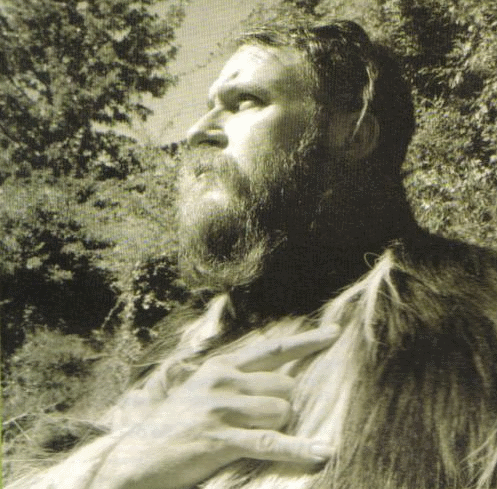
May the Gods Bless Thee,
Matt Anon.
Jhonn’s two friends, and the exceptional artists, David Tibet (Current 93) and Steven Stapleton (Nurse With Wound) say:
“With burning sadness and with burning sorrow we remember You as:
kindest of men, funniest of men, most intuitive of men, most incisive of men, most generous of men, a great artist, a great voice, a great visionary, a great Soul and a great Heart. Finally you were overwhelmed by it all: by all the beauty and by all the pain. You perhaps never knew how much you were loved. Till we meet again as we know we will, our dearest friend, with love always to you dearest Geff, John, Jhonn, shape-shifter and joker, in angelic form now, playing with stars in the love of God. David Tibet and Steven Stapleton”
Here’s to You, Father!
This song has been played by the German band FORSETI and sung by Ian Read:
This is dedicated to my father, who died on April 11th 2008. Having fought communism, you are an example for all those, who fight for Freedom! I love you…
Empfindsamkeit
Siehst du der Felder Leuchten,
Wenn Tau im Morgenlicht
Berauscht vom Rot der Sonne
Durch junge Halme bricht.
Hörst du der Wälder Atem,
Der durch den Abend weht
Und fernen Sturm verkündet,
Der sich schon bald entlädt.
Spürst du die rauhe Rinde
An alter Esche Stamm.
Zerfurcht vom Weltenwandel,
Das Holz vom Nebel klamm.
Riechst du den Duft der Erde,
So regennaß und schwer.
Er strömt aus schwarzem Grunde,
Noch kahl und saatenleer.
Schmeckst du das Salz des Meeres
Im Wandel der Gezeiten.
Ein Sehnen nach der Ferne,
Nach unbekannten Weiten.
Kannst du im Traum erahnen
Verborgener Sinne Macht,
Die deinen Geist begleiten
Durch tiefe Erdennacht.
Liber OZ
Aleister Crowley is an interesting subject of study to magicians. He is both: a failure and a success. Those who strive for the Divine within know that ‘Homo est Deus’. I hereby declare that EVERY HUMAN IS FREE, if (s)he accepts the resposibilty of being a human. But then again, Man is God, as it were. Affix this to every church and every governmental building. Absorb this ‘Zen Dogma’: YOU ARE FREE! 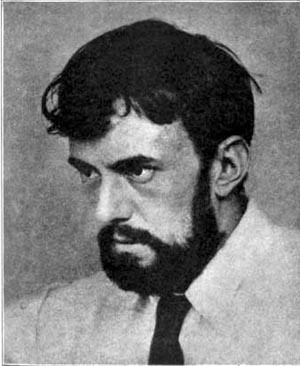
“the law of
the strong:
this is our law
and the joy
of the world.” AL. II. 2
“Do what thou wilt shall be the whole of the Law.” –AL. I. 40
“thou hast no right but to do thy will. Do that, and no other shall say nay.” –AL. I. 42-3
“Every man and every woman is a star.” –AL. I. 3
There is no god but man.
1. Man has the right to live by his own law– to live in the way that he wills to do:
to work as he will:
to play as he will:
to rest as he will:
to die when and how he will.
2. Man has the right to eat what he will: to drink what he will:
to dwell where he will:
to move as he will on the face of the earth.
3. Man has the right to think what he will: to speak what he will:
to write what he will:
to draw, paint, carve, etch, mould, build as he will:
to dress as he will.
4. Man has the right to love as he will:– “take your fill and will of love as ye will,
when, where, and with whom ye will.” –AL. I. 51 5. Man has the right to kill those who would thwart these rights. “the slaves shall serve.” –AL. II. 58 “Love is the law, love under will.” –AL. I. 57 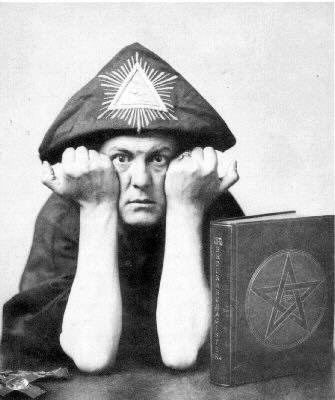
Interview with Jan Fries
I’ve been busy with my studies at university, so that little time remained for this blog. Lastly I’ve been very involved with a paper on Seidhr (unfortunately in German). In this context I have interviewed three people involved in these practices of our ancestors. One of them has been Jan Fries (the two others were Diana L. Paxson and Freya Aswynn [Elizabeth Hooijschuur]). He’s not the main influence to my approach to Rune Work, but his general approach to magick is of relevance and his books Visual Magick: A Manual of Freestyle Shamanism and Helrunar: A Manual of Rune Magick have opened important doors in my mind and soul.
However, the occultnik should become familiar with the objective facts concerning Runology first before engaging in esoteric Work, regardless of how ‘dry’ or ‘boring’ the academic study seems to be to him or her. The objective study of the Runes (academic Runology) should precede subjective study. Otherwise totally subjective systems of the Runes will be the result that must remain without any meaning to others. To put it in other words: you should become familiar with that which is known (exoteric) before you engage in the quest for that which is unknown (esoteric) – not the other way around ;). This approach has been called the Polarian Method by Dr. Flowers / Edred Thorsson formulated.
It’s obvious that Jan Fries’ postmodernistic, relativistic approach supports basically the development of a subjectivistic system. (Even if I don’t know if it’s possible to establish an objective system. But we can at least study what is known.) His refusal of the value of solid academic research and an intellectually ambitious approach to the Runes doesn’t make his work more individualistic, as he somehow seems to believe (at least in my interpretation of our private correspondence). But his “practical pantheism” is very inspiring nevertheless. A certain knowledge of the way our ancestors thought and what they believed could be helpful. The sagas and Hilda Ellis Davidson’s books come to my mind. The dedicated German speaking seeker should study Jan de Vries’ Altgermanische Religionsgeschichte. (I think Jan has used that work too.) First then the esoteric works should be taken into account. Subjective meanings will appear at this stage and they will very likely contradict with (some of) the interpretations of other magical authors. Here Jan is absolutely right: follow your intuition! Noone can help you here except your ‘Deep Mind’ (Jan Fries) or, to say it in a more traditional way, your Fylgja. The only rule is: don’t universalise your own intuitive realisations. (Here Jan’s take on the Runes is again creditable as he always emphasizes that his Rune interpretations are subjective and only of personal meaning.) It is this subjective stage most of us are engaged in. Some say, there is no other stage to reach (than a subjective one), others are convinced that there is a level of meaning that is reflecting a traditional, objective knowledge. It’s not for me here to decide for you what take is the right one, but consider that there exist Vitkis and Rune Masters who have been studying this magical tradition for decades and could possibly teach you a lot, if your mind is open to it. There’s no disgrace in being a beginner. We all remain Learners all life long. Hasn’t once a wise old man said that he knows that he knows nothing? For Socrates all wisdom began with wondering, thus one must begin with admitting one’s ignorance. This certainly applies to the Runic seeker. His search will begin with an irrational, mysterious flash of inspiration, which will cause him / her to seek after the Runes and/or other Mysteries. Jan Fries’ work has its place in the renaissance of Runic Wisdom and will be of use to the practioner of modern magical techniques. I consider Jan’s techniques are worth studying and can be applied in the process of subjective synthesis, when the ancestral Runic wisdom in the seeker’s Soul is reawakening and the life waters are returning to the ancient and dry riverbeds of our forefathers and foremothers.
But get a picture of Jan Fries’ approach and ideas on the magical practices of our ancestors yourself by reading his own words. Though we talked about (postmodern, neo-shamanistic [!]) “Seidhr” you can apply these statements to his take on the Runes, too. Ok, I think I said enough for an introduction to this interview. Here are Jan’s answers to my questions:
Matt Anon: This interview is part of an academic investigation of the practices of Seidhr in the postmodern world. Could you tell me a little bit about your background in the area of magic(k) and/or Neo-Paganism and how you came to practice Seidhr?
Jan Fries: Magic is central to my life. I had my first dreams of Kâlî, Medusa, Lilith etc when I was a child (they usualyy scared me out of my head), learned basic self hypnosis, breathing exercises and vowel singing at the age of eleven from a friend of my grandmother, Dr. Gisela Eberlein, started to meditate in various ways around the age of fifteen, began with Yijing divination, astrology and martial arts at sixteen, rituals at eighteen and so on. My orientation has always been eclectic, I do not believe or subscribe to any tradition apart from ‘find out for yourself’. I respect and appreciate aspects of a number religious, shamanic or magical systems, such as Huang Lao Daoism, early Chinese Wu shamanism, Tantric Kaula, Krama, Mahâcina, Haitian Voudou, non-Crowleyan Thelema, Ma’at Magick and reinterpret the local European pagan religions as I like. If forced to define the whole thing I would call it practical pantheism. However, I believe that the individual is a lot more important than any system, religion, cult or school. And if you have to stick a label to yourself to do your thing you ain’t good enough yet.
As to getting into seidhr, well, I never did think about it. I simply noted that in a number of interesting trance- or obsession states, boddy tends to shudder, sway and shake. More so, it turned out that excitement increases the shaking and shaking can increase excitement. Both of them improve visualisation and produce a state of mind that may look uncontrolled or strange from the outside, but is actually quite focused and lucid from within. As I researched shaking trances worldwide, I found examples in Siberian, Napalese, Chinese, Korean and Japanese ‘shamanism’, in Indian Kaula, the Vedic vipra-seers, Haitian Voudou, a lot of African sorcery, the Mesmeric movement, the medieval Welsh seers and so on. And in one of the trances I had the insight that body is the cauldron while awareness is the seething fluid within. By changing the ‘heat’ (the excitement induced by imagination), the ‘seething’ of awareness can be controlled. It connected neatly with Simrock’s translation od seidhr as Sudkunst, so I began researching ‘shamanic’ elements (or really techniques) in Viking literature. There are some very close parallels.
As I keep emphasising, my identification of seidhr with shaking or trembling trances is hypothetical.
Nor do I claim to teach seidhr, for the simple reason that I don’t know what seidhr really is. After all, Nordic literature on the topic was composed by people who were usually Christian, badly informed or even hostile to the art. And the sources contradict each other. There is not a single statement by anyone who actually practiced seidhr. While we all may guess what seidhr was really all about by emphasising one source and ignoring another, I believe the main thing is not the word seidhr but how people can change their consciousness. The Nordic mystique is just one frame of reference, a useful metaphor if you like. The fact is that seers and healers have used shaking, swaying and rhythmic body motions at least since the Rig Veda was compiled, and regardless whether we call it seidhr or anything else, it happens work.
Matt: Where does Seidhr come from? What was Seidhr in the past and what is Seidhr today?
Jan: Where my impression of seidhr comes from was outlined above. Historically, Viking seidhr seems to have counterparts in the skohsl dances of the Goths and the ‘shamanism’ of the Sami. Not to mention a number of ecstatic trance elements in medieval Island Celtic lore, such as Theo awenyddion which Giraldus Cambrensis daw in Wales, or the frenzied bards at king Maelgwynn’s court (according to Gildas). Such matters are discussed at length in Seidways.
What seidhr is today? I have no idea. All I know is that a number of people do things they call seidhr. You better ask them.
Matt: Why do you think Seidhr should be practiced? What does result from practicing Seidhr?
Jan: Why I think seidhr should be practiced? I don’t. Do you think mountaineering should be practiced? Do you think everybody should go diving?
Look, trancing is not suited to everyone. I don’t know about seidhr, as I don’t know what reidhr really is, but I do know that some people get along perfectly with shaking trances and others don’t. It’s an advanced trance requiring good health and sanity and I would suggest before anyone went into it, a couple of years of regular meditation and daily physical exercise are wise. Nor do I think that shaking trances are a must. There are so many ways of changing consciousness. People do it all Theo time. They get excited or angry, they fall in love, worry or feel sad. The human nervous system has an enormous abilitx for developing and maintaining highly unique consciousness states. You can use ‘shamanic’ methoda, including dancing, shaking, drumming, chanting etc., or maybe Yoga, using posture, breathing, mantra, visualisation, or you could just sit down, induce a deep trance and change your brain rhythms, chemistry and the flow of energy in your body. It’s easy. All of these are conveniences. They produce different states of consciousness, but what happens in them, and how you use (or abuse) them depends entirely on you.
The only thing which I would recommend for other people is to learn how to think and make good feeling. We could do with more happy feelings in this world. When you are happy you make better decisions, and that leads to being even happier. Fellings don’t just happen, they can be learned and made.
Matt: What sources have inspired you to take up the practice of Seidhr? What sources have you studied / read?
Jan: The sources that inspired me can all be looked up in my bibliographies provided one isn’t too lazy.
Matt: Do you think one has to speak Old Norse or has to study the original sources to be able to practice Seidhr?
Jan: I don’t think one has to learn specific languages to practice any sort of magic or consciousness changing. A couple of hundred words of special terminology, sure. Learning languages is fun, but not essential. It’s different when the literature happens to be untranslated. I learned bronze age Chinese as most of the inscriptions have not been translated into European languages. Now some people need old languages for the feeling. Others dress up in costumes, or redecorate their homes. Well and good. Anything that works is fine.
As to the practice of ‘old seidhr’ well, even with Old Norse you won’t be sure what thaz really was about.
Matt: Despite the fact that the term ‘shamanism’ is itself controversial outside the context of Siberian shamanism, do you believe that Seidhr is a kind of ‘Northern Shamanism’? Does Seidhr feature shamanistic elements?
Jan: If we use ‘shamanism’ in the common, Eliade-type definition (which I am not too happy about) as a loose term for ecstatic consciousness changing healing trance ritualism, sure, there are parallels. Read them up in my books. Personally, I am not too fond of the term as it was used in such a sloppy way by a few anthropologists and a lot of fakes. So if we have to use it, then only in want for a better term. I prefer to speak of shamanic techniques, which you find in many cultures, than of shamanism, which is such a wide (or narrow) field of cultural activity that I wouldn’t like to define it at all. Instead of looking for what people call themselves (or others) I prefer to learn what they do, how they do it, how it works and what it is good for.
Matt: What are the differences between shamanism and Seidhr? What are the specifics of Seidhr?
Jan: We had these questions earlier. You tell me what these two things are. What is ‘shamanism’ and what is ‘seidhr’? One term is too vague and the other refers to a phenomenon we don’t know much about, and that is questionable. So please tell me. When you’ve done that you can look for differences and similarities. Or do something worthwhile for a change.
Matt: Do you consider Seidhr as part of the ‘Northern Tradition’ / Teutonic-Germanic Religion?
Jan: I don’t know what you or anybody else understands as ‘Northern Tradition / Teutonic-Germanic religion. In my opinion there are wide differences between the beliefs of various Vikings (about which we know far too little), the prehistoric so-called Germans (about which we know even less) let alone whatever you consider ‘Teutonic’. As I recall the Teutons spoke a Celtic language. So just what are you talking about?
Matt: What is the role of women in Seidhr? Is Seidhr somehow more connected to women?
Jan: Yes, we all read that bit about Odin teaching seidhr to Freya and Theo goddesses. So what? There are a number of seidhrwomen in Theo sagas, just as there are women in many forms of ‘shamanism’. And sure, Tacitus also had his say. Well and good, but I really don’t care. I don’t believe in gender or race, I believe in individuals. As far as I’m concerned, souls don’t have a gender. They get one when they are born, but may have a different one in Theo next life. So Theo only thing I can say is that when it comes to shaking (which may or may not be part of seidhr), in my experience women tend to learn it faster. Simply because of gender roles. Males usually learn to freeze their hisps (to use a metaphor courtesy of Wilhelm Reich) in western cultures, and this can make shaking more difficult. But what does this amount to? Tension can be relaxed and shaking is possible regardless of gender. Just like any other trance state.
Matt: Is it ‘unmanly’ to practice Seidhr? What does that say about the role of men and women in (ancient) Germanic culture? How is this seen in (post)modern Neo-Paganism / Ásatrú?
Jan: I don’t know anything about modern, postmodern or postmortal Asatru, as I don’t belong to any such organisation. I know that some people got quite excited discussing the meaning of argr-, you can find my interpretation in Seidways and Helrunar. And I’ve heard people mixing the matter with trans-sexual behaviour and getting carried away discussing whether homosexuals could be pagans or whatever. Frankly, I don’t care. For me, the whole issue isn’t what any organisation says. It’s about you, on your own, experience in your contact with the divine, whatever you call it and however you contact it. And how it improves your life. Cults, organisations, churches, dogmas etc. only get in the way of true experience.
Matt: Germanic Neo-Heathenism has been often accused of being racist / right-wing? Why do you think that is the case? Can descendents of non-European cultures be part of Ásatrú?
Jan: I believe that (at least some people) get reborn (unless they don’t want to), and that any capable sorcerer should live in several distinct cultures. I don’t believe that the concept ‘race’ means anything. ‘Culture’ or ‘subculture’ may be slightly more meaningful, as you can join or leave them as you like. We are talking categories here. This is a long way from real life. And regarding politics, I cannot say anything about groups I don’t belong to. I can only say that politics and religion are usually a bad combination, as they make people even more stupid than they already are.
Matt: Why do you think so many people feel attracted to Neo-Paganism today (including Wicca, Druidry & Ásatrú)?
Jan: One major reason for the increase of new faiths is that people are not satisfied with the old ones any more. But then, it has always been that way. There has always been an urge to commune or unite with the divine (no matter how you call it), and whenever people organised to do so they defined themselves, they included some and excluded others, and as we happen to inhabit mammalian bodies, they also organised group behaviour in terms of territory, hierarchy and finally power poltics and money. By then, other people got fed up and invented their own faiths. It happens all the time.
Matt: Finally, what answers does Heathenism / Paganism have to the condition of the modern world (including modern challenges like climate change, overpopulation, financial crisis etc.)? In which way does it help to improve the conditio humana? (I would also like to ask in this context: Why is it ‘better’ than the monotheistic cults?)
Jan: In a world which is steadily becoming more integrated regarding communication, travel, trade, work, culture, art etc., poly- and pantheism make communication with other faiths and cultures easier than a monotheistic attitude does. Especially a narrow-minded monotheistic attitude, as in the first commandment. But that’s really all. I don’t believe ‘Heathenism / Paganism’ have any answers to anything. There ain’t such thing. It’s just two words you put together as if they were meaningful. Words, words, words. We are not talking churches or politics, we are talking people. And we don’t talk them either. They all have their own answers. Ask them. And listen.
Out of Chaos Cometh Order: The Holy FUThARK
To the brave may come the vision of the Valkyrie.
Dave Lee
The pathways lead us on since the screaming Lord awoke
Some heed unto the Need when the secret keys were spoke
The bridge wends ever on into worlds both dark and bright
Some hear the inner voice where the silence speaks aright
The journey has no end since such was never meant
Some feel beyond the veil where the ashen spear was lent
The following description of the PROCESS that the Elder Futhark embodies, is purely SUBJECTIVE. I neither claim that my description of the Futhark is ‘true’ in any objective sense nor that it is of any value to anyone else than me. So why present it to others? Well, I would like to think that it inspires others how Runes can be applied on a individual level beyond the general presentation of each Rune as an ‘isolate’, seperate Stave.
A few years ago, when I was doing STAV with a few companions, I was taught to go through a series of ‘Tai Chi’-like movements of which every one was a Rune Stadha (but we were doing this with the Younger Futhark). I’d like to think of doing this with the Elder Futhark as a means of actualizing the whole cosmogonic process (that the Futhark embodies) in oneSelf. One could also sing through the whole Futhark or do the Stadhas & sing the Runes simultaneously. The idea behind this is to anchor the Runes in one’s psyche, so that they can become associated with certain states of consciousness. 
Of course, it’s necessary to do some research and Runic Meditations before one can go through the whole Futhark. But after having stated the obvious I’d like to suggest the idea that the cosmogonic process (the ‘creation’ of the world) is not something that has happened once in a distant past, but that it is an ongoing process. It’s what Goethe called „dieses ‘Stirb-und-Werde’“ („this ‘Die-and-Become’“) that the Runic Process can symbolize and stimulate in the psyche of the seeker. Further I like the idea from Jewish Mysticism that „in the beginning was the Word“. As Galdor is a form of verbal Magic and each Rune Sound (I especially think of the „Kernel-Sounds“ as Thorsson calls them in Rune-Song, p. 33/34) is associated with a certain ‘cosmic’ / magical (cosmogonic ?) energy, it follows that each time we sing consciously the Runes with full concentration, we create the world(s) anew. Magic is then the methodology of re-arranging the world(s) (within or without) by projecting the sonic & visual energy of a particular (combination of) Rune(s) into the cosmos at will.
One word about the Übermensch: I was thinking about my use of the word ‘Übermensch’ in the Third Aett and if it could disturb some readers. But given the fact that the readers of Elhaz Ablaze are surely not ‘mainstream’ & must be rather anarchic spirits, it should follow that you are not ‘brainwashed’ by mainstream media. ‘Übermensch’ (superman) doesn’t imply the idea of ‘Untermensch’ (subhuman). The latter is a perverted creation of the Nazis, not Nietzsche himself. The opposite of ‘Übermensch’ is not the ‘Untermensch’, but ‘Mensch’ (human). It’s my conviction that the Elder Futhark describes an ‘evolutionary’ process on several levels: the cosmonogonic / cosmological and psychological / spiritual level. The ultimate aim of the Elder Futhark on the psychological / spiritual level is, perhaps, the Immortalization of the Soul / Consciousness of the vitki. Such a magician could be considered as a human being that has reached a divine level of existence and all traditions of ancient wisdom have some kind of a word for such beings, for example Xian (in Daoism), Bodhisattva (in Tibetan Buddhism), or Einherjar (in our Heathenism Tradition). I consider the word ‘Übermensch’ as an accurate term, because such a Rune Master is considered to have reached a level that is more than human (which doesn’t mean that he isn’t a human anymore). Yes, of course, this is speculation! It’s my opinion, personal belief, UPG (‘Unverified Personal Gnosis’) – whatever you want call it, dear. My ideas below are inspired by several sources mixed with my own intuition. The sources include diverse artists (bands) & authors like Fire + Ice, Death In June, Ironwood, Chris Travers, Leon D. Wild, Dave Lee, Jan Fries, Sweyn Plowright and Norbert (who taught me STAV for a while). However, the foremost inspiration has been the body of work created by Edred Thorsson – and, of course, my ‘Deep Mind’.
Each Aett has a certain ‘feeling’ attatched to it & represents a certain level of Initiation. I have given every Rune a ‘sentence’ that I somehow associated with each Rune in some of my Runic Meditations (some of them are taken from the lyrics, in part or as a whole, from the bands mentioned above). Then I try to put every Rune in the context of a certain stage of development. The First Aett describes the cosmogonic process (more or less), then I ‘jump’ from that macrocosmic to the microcosmic level (this happens somewhere inbetween Kenaz, Gebo & Wunjo). Please keep in mind that this description is not at all a final piece, but rather a fragment that reflects a part of my understanding of the Runes. Please regard it as an exercise in ‘poetry’ rather than a metaphysical interpretation of the Runes. At some point, it has been suggested, one should write one’s own Rune Poem. I haven’t yet reached that point. However, here we go!
THE FIRST AETT (The Beginning of the Universe / Spiritual Childhood):
FEHU („Eternal Fire. My Being broadens itself over the Vastness of Space!“):
Fehu is the primal movement, the ever extending fire emanating from Muspelsheimr. This eternal extention becomes
URUZ („UR-Form and Form-Giver. I begin to wax and thrive!“):
Uruz is the vital force that shapes all things. Audhumla is licking the Giant Ymir out of the frost that emerged from Niflheimr. As the forms are eternally shaped by Uruz, another force originates:
THURISAZ („Shifter and Resistance-Breaker. My Will is Coming Into Being!“):
Thurisaz is the necessary agent that breaks through all resistance. The three forces of Fehu-Uruz-Thurisaz are so primal, chaotic and ancient that they can only be perceived – in the context of cosmogonic processes – as ‘blind’, unconscious, gigantic movements.
ANSUZ („Ancestral God-Conscioussness. I Give myself to mySelf Eternally!“):
It’s only now that the first consciousness emerges in this evolutionary process that becomes conscious of itself (the First God, Odhinn) – this is the mystery of Ansuz. The triad Odhinn-Vili-Vé dismembers Ymir & creates the universe. This results in
RAIDHO („Holy Order. Rightly I Ride Along the Runic Roads!“):
Raidho – the Holy Order emerges from the sacred consciousness of Odhinn-Vili-Vé. From the Holy Order enflames the spark of knowledge and creativity.
KENAZ („Controlled Fire. I enflame the Holy Spark.!“):
Kenaz is the Promethean Fire given from the Gods to Men. Thus, for example, the discovery of making fire reflects man’s divine ability to use knowledge creatively, which leads to new skills that man continually develops and improves. This is the realm and power of Kenaz. It is also the fire of passion and sexuality, which leads to ecstasy when controlled and used wisely.
GEBO („The triple Gift. The more I Give, the more I Get!“)
Man receives the triple gift (Gebo) from the Gods: the Body (Lík) symbolized by the Tree is ensouled by Life-Breath (Önd) & Consciousness (Ódhr). „Wind and Thought have shaped the Trees.“ (Ian Read) As man fully develops these faculties he reaches
WUNJO („Strength Through Joy, Joy Through Strength. I balance the forces within mySelf!“):
Wunjo represents a perfectly balanced & harmonious state that the aspiring vitki experiences as Joy. Wunjo also embodies the sacred bond of friendship and the Joy experienced in a community. Man is a social animal, but the Runer must necessarily be also a lonely wolf.
Here, in the First Aett, man is spiritually still innocent. The end of this process, Wunjo, is the aim of the naive mystic and in a negative aspect this state can become the obsession for the wooly cotton- brained New-Age romancer. But to the Rune Magician Wunjo is only a necessary requisite.
THE SECOND AETT (The ‘Catastrophes’ & Ordeals of the Magician / Spiritual Maturation):
HAGALAZ („Crisis Leads to Enlightenment. Hail the White Grain!“):
Man’s spiritual childhood is interrupted by a shock that initiates a process of transpersonal growth & spiritual maturity. Hagalaz is the seed of destruction that has encoded in it the seed of enlightenment: the Hail-Stone.
NAUDHIZ („Need-Fire. Seeker, overcome thyself!“):
Naudhiz represents the hardship of life. The Need-Fire is created. This is the necessary friction to test the will of the magician. Finally, it brings progress in his magickal development.
ISA („Silence of Ice. Silence all the senses and listen to the Voice of Silence!“):
In the process of these distressful transformations the vitki must find a silent place within himSelf. By cultivating silence the magician finds a resourceful state within him that is the Region of Pure Will. Thus he develops a mature sense of self without an excessive ego („body armor“). However, nothing ever remains the same…
JERA („Cycles within Cycles. Through Faith in mySelf and my Rhythm I move easily through the Cycles of Life!“):
The vitki realizes that for everything there is a season. As he sows so shall he reap. By observing the cycles of nature he learns about the cosmic ‘laws’. He realizes that the processes in the macrocosmos mirror operations of the microcosmos (his soul). They become allegorical, alchemical keys that bring forth procedures to explore the soul. Thus he finds the World-Tree…
EIHWAZ („Yggdrasil, Pattern of the Worlds. The Fire of the Yew brings Immortality to my Soul!“):
The vitki wanders between the worlds and is taught the mysteries of Life and Death: Eihwaz – Great Initiator! Here he learns about the worlds and their ‘laws’.
PERTHRO („The Three Norns. I Weave my Wyrd with Mighty Deeds!“):
Perthro teaches about the Wyrd and Orlög. Understanding his Wyrd the magician knows there is only one thing worth pursuing: to strive for the Divine within. This is the mystery of
ELHAZ („I strive for my Higher Self. Elhaz Ablaze!“):
Elhaz expresses Man’s longing for the Higher Self. This leads man along the thunderbolt-path, along the serpentine spiral (the shape of Sowilo), to his divine consciousness. Elhaz ignites the Holy Fire of
SOWILO („Eternal Sun, Guide me along the Serpentine Path to the Knowledge of my True Self!“):
Sowilo: the sacred, silent, synthesizing Self is experienced fully for the first time! Here the goal & the way are the same. The Sacred Self is the aim of the magician, but it is also the necessary requisite to travel along the initiatory path without the danger to get lost & become mad. One of the very fascinating features of Runic Mysticism is the fact that this is not the end of the spiritual journey. Rather it’s another beginning.
THE THIRD AETT (The Great Initiations of the Rune Master / Spiritual ‘Übermensch’):
The third Aett shows the Path of the Rune-Master and his Great Initiations…
TIWAZ („Supporter of Heaven, Mighty Pillar of the Sky God!“):
Tyr is the Lord of Law and the Guardian of the Holy Order. The Irminsul is established from within to without. The transcendent centre within the psyche must be fully established – the esoteric location that some German Rune Magicians of the early 20th century have called ‘Thule’.
BERKANO („Pregnant Mother, Container of Strength!“):
Berkano teaches secret growth, the process of Becoming, Being, Decaying and ‘Rebirthing’ is used for the power of the magician. Thus he becomes aware of the Other within. Our ancestors have thought of that quality as a Being independet of the magician’s Self:
EHWAZ („The Golden Wedding. I strive for the Alchemical Marriage!“):
This is „the lonely path towards the eightlegged steed“ (Ian Read). The Fylgja / Valkyrie reveals herself to the vitki. He’s on the cutting-edge of overcoming Death. Marr er manns fylgja („The Horse is the Fetch of Man“).
MANNAZ („Consciousness is Holy. What is Whole, is Holy!“) :
The bipolar structure of man’s consciousness reflects the divine origin of the human psyche. The conscious Mind / Intellect (Hughr) and Remembrance / Intuition (Myne) unite and are enflamed with Inspiration by the Wode-Self. The Well of Urdhr streams eternally from ‘below’ (Jung’s ‘Collective Unconsciouss’ / Myne) to ‘above’ (the Hughr). Thus the ‘super-consciousness’ (Roberto Assagioli) is created at the centre between those three faculties (Hughr, Myne, Wode).
LAGUZ („The Waters of Eternity open up. Flow Along the Runic Rivers!“):
Laguz is the final test. The ancient waters of Life-Force, the Ur-Waters streaming from Niflheimr, pervade man’s Mind, where the accumulation of wisdom & his transpersonal growth become an endless process, if he’s on the path of the Rune Magician, because Laguz is a crucial point. I would like to define the path of the magician against the path of the mystic here (for the sake of playing around with ideas):
You could say that these forces – Laguz – are so strong that the sense of Self will be absorbed by the ancient waters (the path of the mystic). Mystics often speak of this experience as an ‘oceanic feeling’ (cosmic consciousness). One could say that the mystic cures his fear of death by confronting Nothingness (Dave Lee). He gives in & submits his sense of Self to the Life-Force (Laguz); the cosmic Ur-Waters of Laguz ‘consume’ him. He looses his individuality & dissolves into that Cosmic Ocean like a drop of rain. From the mystic’s point of view the following happens: He realizes that he has no individuality, it’s an illusion – he has always been the Ocean. Thus he looses all fear. In the context of this article, I want to argue that, if any mystic could follow that initiatic path so far, his journey ends here.
The magician instead has to ‘seperate’ his Ek from that turmoil, because magick is about control. LHP magicians are control freaks! But this Ek is not the ego at all, as Dave Lee so aptly demonstrates in his Master Work Bright from the Well. Rather it is Spare’s Kia, Verdhrfölnir or the ‘Ultimate Observer’ (de Ropp’s ‘Fourth Room’ or Lilly’s ‘Center of the Cyclone’ or Osho’s ‘The Watcher on the Hill’). To stay in the metaphor from above: The rain drop does not dissolve and mingle with the Cosmic Ocean, but remains its individuality.
INGWAZ („The Principle of Wihaz. Gestation and Transformation. Man, Become God!“):
By isolating himself from all these changes around him, the vitki starts a controlled process of absolute transformation. The storage of the Life-Force of Laguz leads to the gestation of the Seed of Immortality. This seed becomes the ‘Body of Light’ (or what the Vajrayana-Buddhists call the ‘Diamond Body‘). „Man finds his Ing“Rune Games, Osborn & Longland).
DAGAZ („The Morning of the Magician. Atheling, Awake!“):
Dagaz dawns as the darkly shining Noxia-Licht („Night-Light“) of Enlightenment. This Rune is central to the understanding of the essence of Odhinn. Dagaz leads directly to the synthesis of all polar extremes. It’s the Paradox that lies at the centre of the Mystery of Wodhanaz. By uniting the opposites (f.e. ‘Man’ & ‘Woman’) a third thing is born (f.e. a ‘Child’). This is an eternal process. The journey has no end since such was never meant.
OTHALA („Eternal Soul. I, the Winged Ing, repossess my own Space!“):
Othala represents the individuated psyche (in a Jungian sense). This is man’s reclaimed estate of kingly existence, his Immortal Soul. „There are Thrones underground and Monarchs upon them.“ (Coil)
Putting Dagaz as the last Rune of the Futhark could symbolize that the process of ‘uniting the opposites’, that finally leads to what has been called enlightenment, is eternal and never-ending. On the other hand as Fehu symbolizes movable possession (the extension of the Self), Othala represents the end of this process, symbolized by the ‘rewon’ kingly estate (the perfected Self).
I’m in the beginning of learning Galdor. It seems to be a very difficult art. The Runes – the ‘tools’ of Galdor – seem to be of such a mysterious nature that they never can be understood fully. When you move nearer to them, they seem to move further away from you. This lies at the centre of the mystery of Runa. It has been said that the fatalistic acceptance of the fact that Runa will never be fully grasped is the hallmark of a true Odian (a seeker who does not worship Odhinn, but rather emulates the way of Odhinn). Such a vitki explores the dark magick of the Germanic LHP. Let me conclude with the words of a magician, whose words never fail to illuminate my mind:
“In galdor-type magic, the self is fully-conscious at the moment of projection of the will. In other words, the magical self extends its will at the same time the observing self sees it all happen. The observing self is unfazed by the focus of the magical self – context is not lost, even though the magical self is in a narrow, focused, fanatical state. This is the nature of this kind of magic – that the observing self is present throughout it, and that the consciousness of the wizard is doubled.
So, what we are really developing in our magical work is the ability to split our attention in this way, to bring the observer-perspective into even our most passionate and intense trances. The path of the magician emphasizes both the transcendent and the immanent, worldly aspects of life, in contrast to the way of the mystic, who seeks to transcend the whole show.”
(Dave Lee, Bright from the Well, p. 134).
Reyn til Runa.
Why Be a Chaos Heathen?
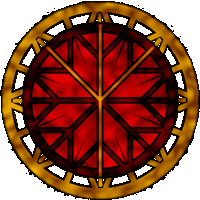
The Elhaz Ablaze Sign, designed by Donovan
The following article was intended as my first one for Elhaz Ablaze. Somehow I never finished it. But as Elhaz Ablaze has had its birthday a few days ago, I think it makes sense to write my own story how I came to call myself a Chaos Heathen. The first time I read about Chaos Heathenism and the explanation of it written by Heimlich I felt that it resonated with my being very strongly. Though I personally think that one-word descriptions (or two words in that case) cannot really express who I am and how I feel, I still think that the term Chaos Heathenism is really a gem.
„Why Chaos? Why Heathenism? And what is Heathenism anyway?“, I heard some of my friends ask. Friends of mine – most of them – don’t call themselves anything and, if they are religious (or spiritual, as most of them would prefer that term), they don’t like the idea of belonging to some kind of philosophy and/or religion. So, what is Heathenism? (I know that most readers of Elhaz Ablaze already have a very clear conception of what Heathenism is.) Basically, I think that Heathenism is the ‘religion’ of our ancestors. But it’s not really a religion, it’s more a way of life, or to be even more accurate, a ‘way of doing’. However, this way of doing is based on certain philosophical / ‘religious’ concepts that imply powerful truths about the nature of reality and consciousness. To me personally Heathenry is really about roots (RE-connecting with your ancestors & the ancestral, primal root of consciousness – ANSUZ), the interconnectedness of everything (Wyrd) and about a living, ‘ensouled’ universe/multiverse with which humans can communicate by interacting with ‘beings’ that are imagined as gods, elves, dwarfs & other mythical beings (Esoteric Runology). And, of course, Heathenry is about values (like honour & loyalty), where one’s deeds & words count for something.
But the values of our ancestors implied also a very different approach to the Divine. I’ve been raised as a Catholic and to me God has always been associated with fear (to some degree). Heathenry is very different from such an attitude. The arch-heathen would be able to argue, laugh & talk with his / her Gods. There were also Heathens that only believed in their own ‘might and main’ – rather than in any Gods. But the difference between such an arch-heathen and a modern atheist would be the basic feeling about the universe. The modern atheist basically feels that the world around him is without any meaning (except the one attatched to it by the individual), while the arch-heathen felt a mystical ‘web’ of mystery surrounding him/her and carrying the very fabric of his/her existence (cp. Jan de Vries: Die geistige Welt der Germanen). This is the huge difference, from which very different attitudes towards life and its possibilities arise. This includes a very different attitude towards death, too.
I’d argue (like Edred Thorsson in his brilliant The Northern Dawn – a must-read for anyone, who believes that the heathen worldview is somehow lost and not accessible to us anymore) that modern atheism and its most intelligent and sensitive articulation, existentialism, is a consequence of the monotheistic cult, Christianity. The Kristjan (old way of spelling Christian) worldview NEVER suited to the European ‘soul’ – our ways of thinking & feeling, fighting & loving, doing & being – and it was only a matter of time until it deconstructed itself. Further, what appears Kristjan on the surface is often Heathen beneath its appearance (Yul / Xmass, the Xmass Tree, Easter, Easter Eggs etc. etc.). And many early Kristjan ideas have been ‘germanized’ just to fit to the Heathen mind! Otherwise many Kristjan ideas wouldn’t have been even understood by our Heathen ancestors. Consider how brutal and cunning the Kristjans have been just to realize, why they have converted to a creed that has been totally alien to them. After these important considerations have been ‘digested’, it doesn’t appear so weird anymore (though it’s certainly Wyrd), why being a Heathen in these modern times is like ‘coming home’ or ‘becoming who you are’, rather than just following another foreign cult and/or religion. So, to put it in plain view: when (young) people feel the sacredness of nature, or feel drawn to magic(k) or the Runes or pagan deities asf., I consider all these manifestations as authentic expressions of Self – our Heathen ‘soul’.
But then, why Chaos? First of all, the Chaos perspective just admits that the world has changed dramatically since our Heathen forebears lived on this planet and we cannot (and do not want to) turn back the clock. Our ancestors have been so succesful, because they were pragmatic and knew how to adapt to new challenges. Otherwise they wouldn’t have survived and we woulden’t BE HERE NOW (this being a mantra to achieve a state of real wakefulness :-). The chaos perspective allows us to draw new inspirations from different contexts as we are able today to connect with and elect from many ideas, philosophies, magics, techniques & cultures that surround us materially and virtually. So I don’t consider it as ‘untrue’, when I find myself ‘working with’ Ganesha or Kali (or any other deity I feel drawn to) and/or when I am exploring magical paradigms/techniques/ideas that are not part of the Heathen Lore. (Though, honestly said, I’m beginning to become very sceptical of ‘working with’ Gods from different cultures as this approach of ‘working with Gods’ seems to be disrespectful to other cultures and to the deities themselves. However, this is a topic for another article…) But there is another aspect: the chaos magickal or freestyle ‘shamanic’ approach just suits to many of us rather than a strict, ceremonial way of doing magick (though I tend to like both & lean a little bit more towards a strict way of doing rituals). I’d argue with Freya Aswynn that the Northern Tradition is far more in harmony with chaos magick than a Western ‘Ritual Magic’ approach.
“The magical arts of the Northern peoples covered a wide spectrum of activity, all of which was purely practical. There was none of the Qabalists’ occupation with building a stairway to the Deity, no Golden Dawn mysticism. It was, as the poet T. S. Eliot so aptly put it, ‘designed to produce definite results, such as getting a cow out of a bog’. If it bears a resemblance to any modern magical system then the most likely candidate is Chaos Magic…“ (F. Aswynn: The Northern Magical Tradition. In: The Fenris Wolf, Issue No. 3 (1993), ed. Carl Abrahamsson, Psychick Release Production Cerebrum & Press, Stockholm.)
I personally like the idea that Galdor represents a more ‘strict’ way of working magick and that Seidhr equals the chaos magick approach. However, a Chaos Heathen is someone who doesn’t deny his/her many ‘selves’ and will move on to new horizons of understanding. This should be reflected in one’s own magickal practice. For example, if one still uses the same approach to sorcery after some years of practice, this would reflect that no real progress has taken place. For me Chaos Heathenry just expresses an attitude that allows for more experimentation, free exploration and an undogmatic, fresh perspective. A chaos heathen won’t bother too much about debates that ‘it isn’t historically proven’ to use Runes or Seidhr in such-and-such a way. S/he knows also that it’s not much that we know and that the way historical information is interpreted & presented always reflects the individual agendas of the persons using them. That doesn’t mean that I as a Chaos Heathen dismiss Tradition, but that I believe that one of the cornerstones of that Tradition has been innovation and a creative spirit – not orthodoxy (being a rather Kristjan obsession). Of course we have to avoid New Age nonsense. But we don’t want to fall into the trap of dogmatism either. There is no ‘one right way’ of walking the Runic Path. The Lord of Light & the Drighten of Darkness HimSelf was/is a couragous, creative, innovative explorer & shape-shifter, wandering restlessly between the worlds, always ready to look behind the curtain and to find a new secret. I think that to emulate this spirit in the here-and-now is more noble than to try to live in the distant path of our ancestors. If Othinn was alive as a human being today, he would be a Chaos Heathen. May His Power be Mighty amongst us!
Hail Chaos! Viva Loki! Aum Wotan!
Storytelling as the Weaving of the Self
We moderns have nothing whatsoever of our own; only by replenishing and cramming ourselves with the ages, customs, arts, philosophies, religions, discoveries of others do we become anything worthy of notice.
Friederich Nietzsche
Exit all legends, enter the laws of magick.
Genesis Breyer P-Orridge
“You got no love in your heart. When you got no dreaming, no story, you got nothing”, an Aborigine says to the hero in a movie called ‘Australia’ (the movie is crap, but I’m used to look for gold in shit). The aborigines have a very mysterious concept that they call dream time, this is the mythical & magical time, where the ancestors still live & sing and every thing has a ‘song’ attached to it: rocks, trees, bushes asf. – all have a ‘song’. And the initiated sorcerer of the Australian natives can communicate with these ‘things’ by singing their songs (a form of verbal magic, in Norse magic represented by Galdor). Here we are once again confronted with the holistic vision of a sacred landscape, where everything is interconnected & alive – a worldview that was also common to our European ancestors (or wherever your ancestors come from). This vision is contrary to the modern myths created by the visions of Descartes & ‘Newton’s sleep‘ (William Blake). Both of them had literally visions. Descartes’ thinking has been influenced, for example, by his dreams & Newton has been an occultist, who has received his vision of the mechanistic ‘clockwork universe’ from an ‘Angel’ of the Enochian system of magick ‘invented’ by Dr. John Dee. 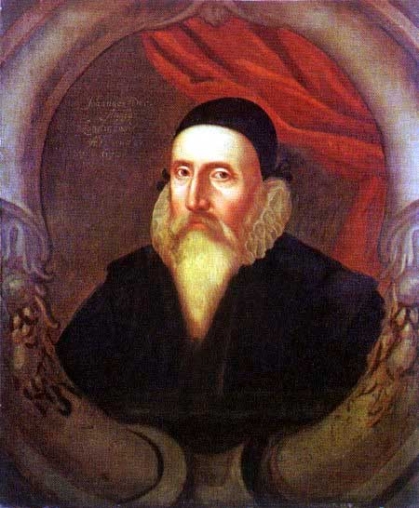
Their visions are the stories about the universe we are brought up with. (If you have really bad karma you have been brought up with Kristjan stories about the universe :-). They do not stem from dream time, but from the modern myth of linear time. (‘Our enemies are material. Our enemies are direction and fact. Our enemies are Because.’ GP-O)
Anyway, what really strikes me is the idea how much power a story has over our lives and that – since nobody owes the absolute truth, if such a mysterious thing exists at all – all religions, philosophies, myths, histories, fictions and movies are essentially stories, stories we tell ourselves or that are told to us. Of course, this is a postmodern attitude that I am extremely wary of as it includes the risk of fundamentalist relativism and an ‘epistemological hypochondria’ (Geertz), where ‘anything goes’ and thus real knowledge becomes impossible anymore. But everything has two faces and there are also great advantages, when one uses POMO thought in a critical & self-conscious fashion.
“Post-modern research … embodies a critique of the conventional logical positivist discourse derived from rationalist Enlightenment philosophy, which privileges the European, male, individual subject and the indisputable authority of scientific explanatory frameworks.” (Robert J. Wallis 2003: Shamans/Neo-Shamans: Ecstasies, Alternative Archaeologies and Contemporary Pagans, p. 2).
I think this critique is a necessary step, if one really wants to understand the local knowledge of a native people, like the Aboriginal tradition (or our Heathen tradition). This means, too, that to select carefully a few essential tenets of postmodern philosophy can bring about changes in attitudes, values, perceptions, and worldviews that help us to heal the wounds between ‘whites’ and the peoples we have hurt (see Henry’s article Culture, Genocide and Whingers). More generally speaking, such a ‘paradaigm shift’ on a grand scale can help us to heal the wounds between humanity and the Earth Spirit (Anima Mundi). 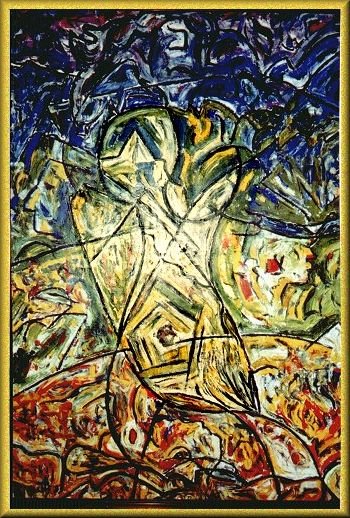
Further, the positive effects of postmodernism can be, if used wisely, that we deny to follow ‘universal rules’ (of life, art, philosophy, or anything else). And those who have the will and determination can choose pathways to individual fulfilment & self-empowerment based on the story (‘paradigm’) chosen or created by themselves, instead of following the universal appeal or supposed authority of a story they were told to believe (be it religious metaphysics or scientific materialism, or whatever your favourite mental prison is). If something feels internally authentic & right, it’s the way to go. For us Chaos Heathens / Pagans this attitude makes it possible to liberate us to return to the trú traditions of our ancestors in new, exciting, and creative ways, in ways that adapt and apply the ancient wisdom to the circumstances and the Need – in the sense of :ᚾ: – of our times.
However, to me storytelling is a form of magick and a form of knowledge. Imagine a tribe 10,000 years ago in a dark forest at night. You can hear the wolves howl, and you hear the strange sounds of other dangerous animals, above you the stars and a full moon. Only a little bonfire enlightens the night and you sit there in a circle with your comrades, the shaman of your tribe – a miraculous man with special powers, who is treated with awe by all men of the tribe – sits with you there and tells wyrd stories of cosmic, uncontrollable and daunting forces, of Fire and Ice generating the events that created the universe. He tells you about Ymir, the bipolar Giant, dismembered by the mighty Gods, Odhinn (Master of Ecstasy), Vili (Sacred Will) & Vé (Hollowed Space), who made order (Futhark) out of the totality of existence (Ginnung) and shaped the first man & woman, Askr and Embla, out of trees (!), giving them the triple Gift (Gebo) of human shape (Lík), life-breath (Önd = Prana, Chi, Libido) and (divine) consciousness (Ódhr). His stories tell you about the adventurous journeys and brave deeds of heroes that are your direct ancestors, whom maybe your dead great-grandfather met personally, when he was a child. These journeys of those heroes turn into ordeals & initiations, where they gain insights into the mysteries and cycles of birth, life, death & rebirth. These stories are strange allegories that illumine your understanding of the world surrounding you. They give you heroic models of behaviour that help you to live in an honourable way. Our shaman from 10,000 years ago is a storyteller. He creates a sense of self, of who and where you are. He gives codes of meaning & an intelligence to your life that makes you aware of the interconnectedness that the Web (Wyrd) woven by the Three Norns originates. Magick is possible here – you are not alone, disconnected and alienated from the world! 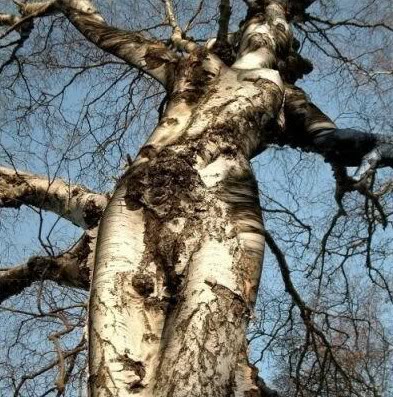
But 10,000 years later these stories of old are not told to us anymore. They became myths in a negative sense, fantasies of stupid, uneducated, brutish barbarians. The modern stories describe such states of consciousness (as mentioned above) as being ‘primitive’, ‘infantile’ and ‘wishful thinking’. They are something that must be ‘overcome’ by logical & scientific thinking. The French ethnologist Lévy-Bruhl interprets such a healing and wholesome state of unitary consciousness in a negative sense as participation mystique and the Austrian psychoanalyst Freud called this ‘magical thinking’ (based on his idea of primary narcissism). ‘Magical thinking’ is the belief that a person can impact reality by wishing or willpower. Such a belief demonstrates a belief in the self as powerful and able to change external realities. To put it shortly, magical thinking is in many ways what I strive for! For many years now, I try to decondition myself from this vision of ‘flatland’ logic by psychedelic drugs, meditation and magick (more or less successfully until now :-). Though in the long run POMO thinking is not at all ‘magic-friendly’ and, though the whole POMO current has created in many areas a body of knowledge of rather dubious value, I still believe that on a philosophical level some POMO ideas are useful to regain ‘magical thinking’ in a positive, ‘enlightened’ way, namely by creating new stories. Don’t get me wrong, science is invaluable! But the scientific story – if not balanced by wisdom, if not shown where its authority ends, and if not shown where it failed (!) – has not much (interesting) to say about the most important questions of life: What is the purpose of life? What happens after death? What is wisdom? Or, if I may quote again my ‘Aboriginal friend’ (from Hollywood:-), his answer to science would be the same as to the white man: “You got no love in your heart. When you got no dreaming, no story, you got nothing”. This is not completely true, of course. Science has a story: it dreams of ‘eternal progress’ and a condition where all disease, probably even death, is cured. For those who haven’t been so optimistic, it has created nihilism. And what is the story of nihilism? It goes: “The story is pointless. It all makes no sense. End of story.” But we Need a story. A brighter story, a greater story, a hopeful story!
But what can a story do on an individual level? Isn’t a story just a story? Well, yes and no. For example, what is the ego? From a meditative point of view, my ego is just the stories I tell myself about myself. But some stories are charged with a very high emotive energy. So, before my ego would give up its ‘core’ stories, it would probably run mad & defend them from extinction like a religious fundamentalist would protect his belief in God, just because the ego consists of these stories. Probably that’s why it’s so hard to ‘Cross the Abyss’, as Crowley has put it. Probably that’s why most humans fear death! Probably that’s why it’s hard to change at all! Because, you know, ‘that’s just the way I am!’, so I won’t give up this-or-that habit or such-and-such a way of thinking or repetitive emotional pattern, even if it’s bad for ‘me’. Because ‘that’s me’! You get the picture… The ego will all-ways convince you with its stories, why you shouldn’t change, why meditating is boring, or why you have the right to behave angry, feel depressed or be xenophobic. So, in a fundamental way, it’s of great importance what story dominates you, what story you tell yourself about yourself. This, probably, is the reason, why meditative systems of the East have only little use for ‘developing a strong personality’ etc. and focus very much on developing ‘egolessness’, developing equanimity towards life, pain & death and fostering devotion towards the God/dess or the guru, who represents the God/dess and, ideally, works as a ‘mirror’ for the apprentice. Our Northern Tradition fosters instead the development of a strong Hamingja (cp. Sweyn’s True Helm) and of courage towards life, pain and death (cp. Dave Lee’s Bright from the Well: Northern Tales in the Modern World).
On a more profane level just consider what psychotherapy basically does to people. It just gives them a story, a meta-narrative, that makes sense out of all the shit that went wrong and by explaining why this shit has led the individual to feel ‘so-and-so’ about himself. By giving sense to that which seems senseless, by explaining the pain and giving it a meaning, and by telling the person that s/he is not defined by its past and that s/he can now choose to do better. Basically, it creates a better story and thus a better ‘self’ – the stories, of which the ego consits, are changed! (‘Change all memory. And change your ways to perceive.’ TOPY proverb) In a way, the therapist is a modern echo of the storyteller, as is, of course, the priest. But finally that’s not enough, because today, if you are a genuine member of the holiest of all holy orders, the COT (= Club Of Truth-seekers :-), the truth of someone else won’t suffice. The shamanic storyteller from 10,000 years ago is dead and gone. The only one who can ‘replace’ him today is not a politician, priest, psychotherapist or some self-proclaimed guru, but it is you. 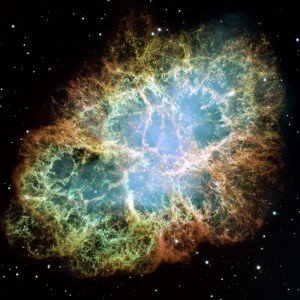
Remember You Are Made Of Star Dust
So creating your own story is a good starting point. The chaos magician Andrieh Vitimus suggests:
“The imagination is more powerful than merely the facts. An idea backed by emotional responses can be seductive enough to enslave many to its cause, whether the idea is a spirit, a piece of art, a cause, or a concept. The majority of people seem content to give away their imagination and creative power. Often, this manifests in letting other forces (advertising, religion, ideas, spirits, whatever) decide what they should do and what they can have and be. This is the power of imagination. It can free us or be our worst prison.” (Andrieh Vitimus 2009: Hands-On Chaos Magic , p. 365, my accentuation)
In days of yore Imagination was a natural part of daily life and regarded as valid as any other human faculty. Walliam Blake, whose Poetic Genius has created a unique poetry (see ‘The Proverbs of Hell’), embraced Imagination as ‘the Body of God’. Today our Imagination, our visualising asf., is ‘stolen’ by the story-sellers, who created the ‘Body of (Pavlov’s) Dog‘. Advertising is a good example. It sells ‘imagination’. So you buy the ‘myth’ surrounding the package, not the content itself. You don’t buy a perfume, but the ‘imagination’ that it makes you more erotic, attractive, seductive asf. Today we have no genuine storyteller except, probably, the artist. For example, artists who sing about the way they experience truth, like this one: “Waking sleep, cocooned within a veil of fog, Sight no further than my hand, Tearing at this web spun through reality … Through the sacred dance I Awaken, Through faith in myself and my rhythm, Conscious for the first time…” (Ironwood – here’s a fantastic German review). But today such artists are rare. Because in these modern days even the artist has become a whore of capitalism and thus he turned from a genuine storyteller to a storyseller – a faker, a peacock, a good-for-nothing. Mehr Schein als Sein (‘More Appearance than Being’). And stories they sell, packaged in a ‘consumer-friendly’ form, devoid of meaning and any real depth. A true storyteller, shaman & madman, Jhonn Balance (now dead dead dead – may he be blessed by all horned animals!), has warned our culture by proclaiming that Constant Shallowness Leads To Evil! The German artist and shaman (of sorts), Joseph Beuys, has said once: Every human is an artist. I would like to add: …and a storyteller. At least s/he should be. POMO theory started out when it proclaimed that there is no ‘grand narrative’ anymore (that the ‘scientific myth’ of modernity of eternal progress & secularization has kind of come to an end – that’s why post-modern). So, after Nietztsche proclaimed that ‘God is dead’, now the ‘grand narrative’ is dead, too. But I believe that we, as individuals and as a folk, need a narrative again, a story. And, in this globalized world, we need also a story for the earth community – a story that makes us aware of the interconnectedness of everything on this green-blue and fragile planet. Because when I poison the air over here in Europe, your air will be finally poised over there in Australia, too. So what could this story be about? Well, I’m not wise enough to answer this question, but we can silence our minds and listen to what the voice of our hearts has to say (what our ancestors called ‘High Rede’). And surely we can look with confidence to the wisdom of our ancestors and apply it. If the climate catastrophe shall be anticipated in time, science must be part of the solution, I believe. As the Permaculture slogan goes: ‘The problem is the solution.’ Mid-gard – Middle-Earth must be guarded, and it can only be guarded by us humans.
